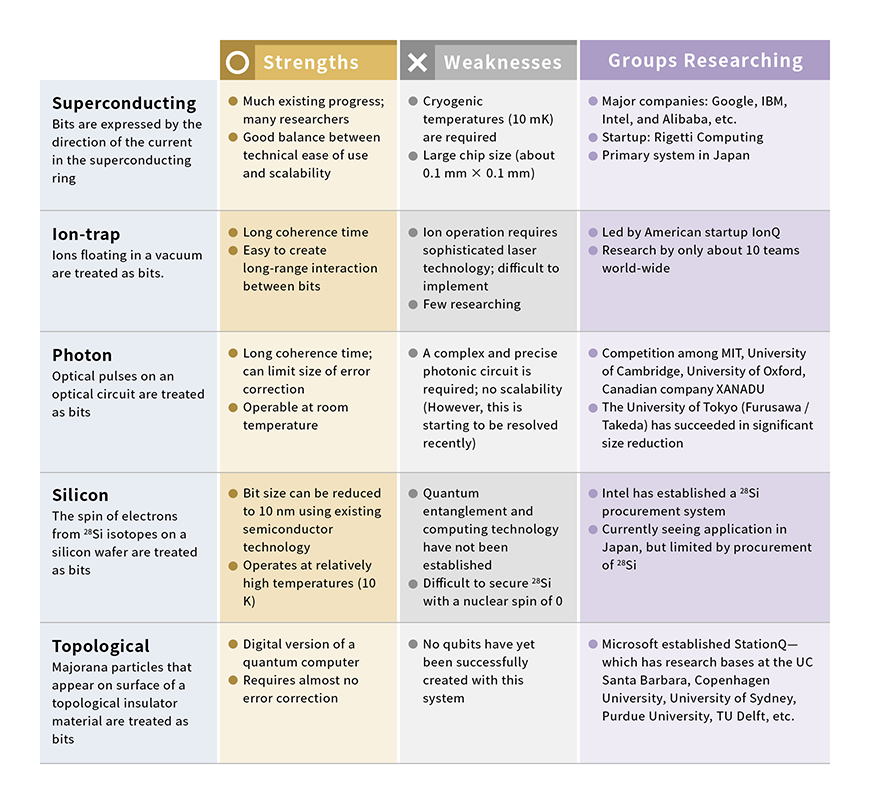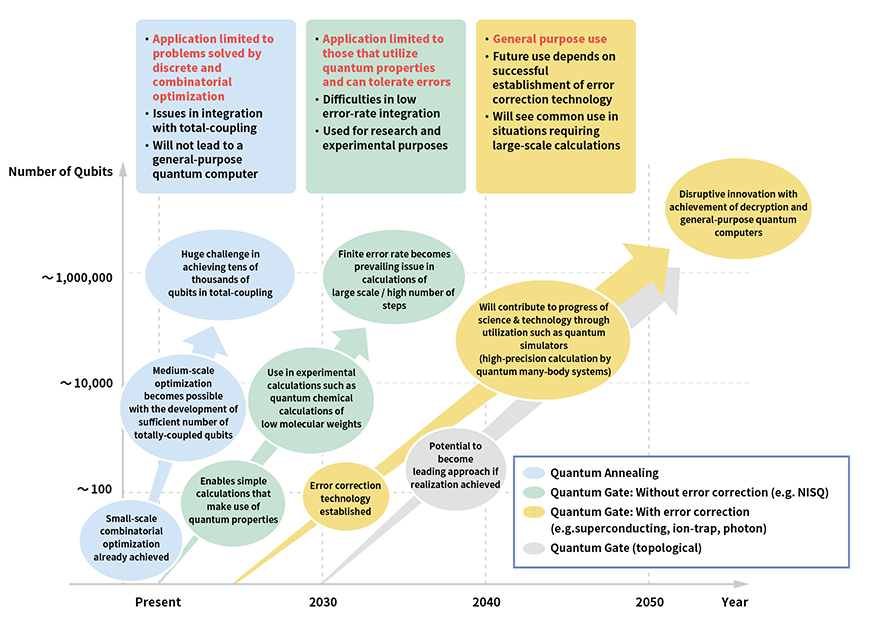
A world where pressing issues are resolved with computers running on quantum mechanics
Achieving Scalability:
The key to future quantum computers
Two Main Approaches as Competition Takes Off in Quantum Computer Development
Research on quantum computers has been accelerating at an unprecedented pace. The United States, Europe, and China have all launched large-scale projects each featuring 10 to 20 billion yen in annual government investment. While IT giants including Google, IBM, Microsoft, Intel, and Alibaba are leading a majority of research efforts, a variety of smaller companies are undertaking their own initiatives with multiple startups currently developing quantum computer software.
Various approaches have been proposed for building quantum computers and can be broadly classified into two types: quantum annealing and quantum gates.
Quantum computers that apply quantum annealing principles of computation are dedicated machines specializing in combinatorial optimization, or searching for the optimal solution to a problem among an enormous number of combinations. Experts are divided on whether to include quantum annealing in the realm of quantum computers, but we will consider them as such in this article. However, it should be noted that we will not be including annealing methods using digital circuits such as those developed by Fujitsu and Hitachi.
Quantum computers applying the quantum gate approach are multipurpose devices. The term “quantum gate” is derived from the logical gates of conventional Neumann computers that are used in the processing of calculations.
Let's take a closer look at each below.
Quantum Annealing Approach: High-speed specialized machines already seeing practical application
Quantum annealing, an approach to quantum computing, was proposed by Professor Hidetoshi Nishimori and colleagues of the Tokyo Institute of Technology in 1998. It attracted much attention when D-Wave Systems (Canada) launched what they claimed to be the world's first commercial quantum computer in 2011. The quantum annealing method solves combinatorial optimization problems by reducing them to the Ising model mathematical formula. The Ising model is a well-known model used in many fields such as in ferromagnet theories of physics. Solving the Ising model makes clear the conditions for minimizing energy use, which can be used in solving optimization problems.
The most famous application of the quantum annealing approach is route optimization. A problem representative of route optimization is the traveling salesman problem (TSP) that seeks to answer the question of how a salesman can travel among multiple cities in the minimum total travel distance. Quantum annealing has the potential to solve real world problems such as the optimization of delivery routes. Already, Volkswagen has lead efforts in conducting demonstration experiments on the optimization of traffic in Beijing using quantum annealing computers.
Quantum annealing computers have already begun to see commercialization as quantum computers using superconducting quantum bits (qubits). However, there are two major technical challenges impeding further progress: the realization of large-scale integration and the realization of total-coupling. In the above-mentioned TSP example, large scale integration corresponds to the number of cities, and the number of connections for coupling corresponds to the constraint of movement from city to city. These challenges must be overcome before larger and more precise optimization problems can be solved.
On the other hand, quantum annealing computers can instantaneously solve small-scale problems and optimization problems that feature only partial combination; these problems cannot be easily solved by conventional computers. The framing of pressing, real world problems as combinatorial optimization problems should lead to solutions developed through diverse applications of these advanced technologies.
Quantum Gate Approach: The top candidate among quantum computers for disruptive innovation
The quantum gate approach to quantum computers processes complex algorithms by manipulating the quantum gates. While conventional logical gates perform logical operations using information expressed by binary “0” and “1” values, quantum gates perform calculations by controlling a state of superposition of both values “0” and “1” and their phase difference (See Quantum Computers Part 1).
Various methods have been proposed for the realization of quantum gates, based on a wide range of systems for physical representation of qubits. Such systems include superconducting, ion-trap, photon, silicon, and topological systems. Each system has its strengths and weaknesses (Figure 1) with competition among corporations and research institutions in the development of promising methods.
Features of Systems for Realizing Quantum Gates

Source: Mitsubishi Research Institute, Inc.
Quantum gate-type quantum computers are also known as error-correction quantum computers. While the manipulation of qubits does not require switching between 0 and 1, it requires analog control of aspects such as superposition and phase difference. The proper control of error is essential for the accurate execution of large-scale calculations. The issue of error correction is addressed with quantum error correcting codes that encode multiple physical qubits as logical bits. Examples of problems that can be solved faster with quantum computers than with classical computers include decryption using Shor's algorithm for integer factorization and ultra-highspeed database search based on the Grover's search algorithm.
Establishing error-correction technology and creating a sufficient number of stable qubits remain the largest challenge with quantum gates. The uncertainty principle renders the copying of qubits, and thus error corrections, impossible, which led many to believe that the development of quantum computers too was impossible. However, a method for correcting errors in qubits has subsequently been proposed that calls for observing and determining the causes of error, instead of examining the error itself, by utilizing qubits in the entangled state.
Furthermore, error can be corrected through the generation of multiple entangled qubits and their proper manipulation. Such procedures require the ability to handle a large number of qubits with sufficient coherence time (i.e. the period of time the state of quantum entanglement remains stable) and the development of error correction technology that can be stably controlled. As soon as these key issues can be addressed, quantum computers will have a disruptive impact on society.
In the correction of errors, multiple physical qubits are required for one logical qubit. Furthermore, Shor's factorization algorithm and Grover's search algorithm require 10,000 to 1 million logical qubits. However, present reports of physical qubit creation through the quantum-gate approach have only been on the scale of tens, and quantum computers capable of executing advanced algorithms are still far from realization.
Scalable Mechanism Key to Developing Quantum Computers
Whether the quantum annealing approach or the quantum gate approach, the primary bottleneck to the development of quantum computers lies in the fact that no scalable mechanism has yet been established.
In quantum computing, the scalable mechanism is the capability to handle an increasing number of qubits in an increasingly stable manner. The capabilities afforded by scalability are required to achieve goals such as a general-purpose quantum computer and the feat of decryption. Current quantum computers using the quantum annealing approach achieve several thousands of quantum bits and have seen successful application to combinatorial optimization problems. Further, NISQ (noisy intermediate-scale quantum computer) quantum computers are being explored as a solution that utilizes only a small number of qubits (a few hundred) without the need for error correction. However, many remaining technical challenges must be overcome before further scalability can be achieved (Figure 2).
Rapid progress has been made in the innovation of various component technologies through massive allocations of funding and personnel mainly in the United States and China. However, the realization of quantum computers able to meet the original expectations surrounding the technology depends on the integration of these component technologies and the development of scalable mechanisms.
Future Prospects of Quantum Computers by Approach

Source: Mitsubishi Research Institute, Inc.
